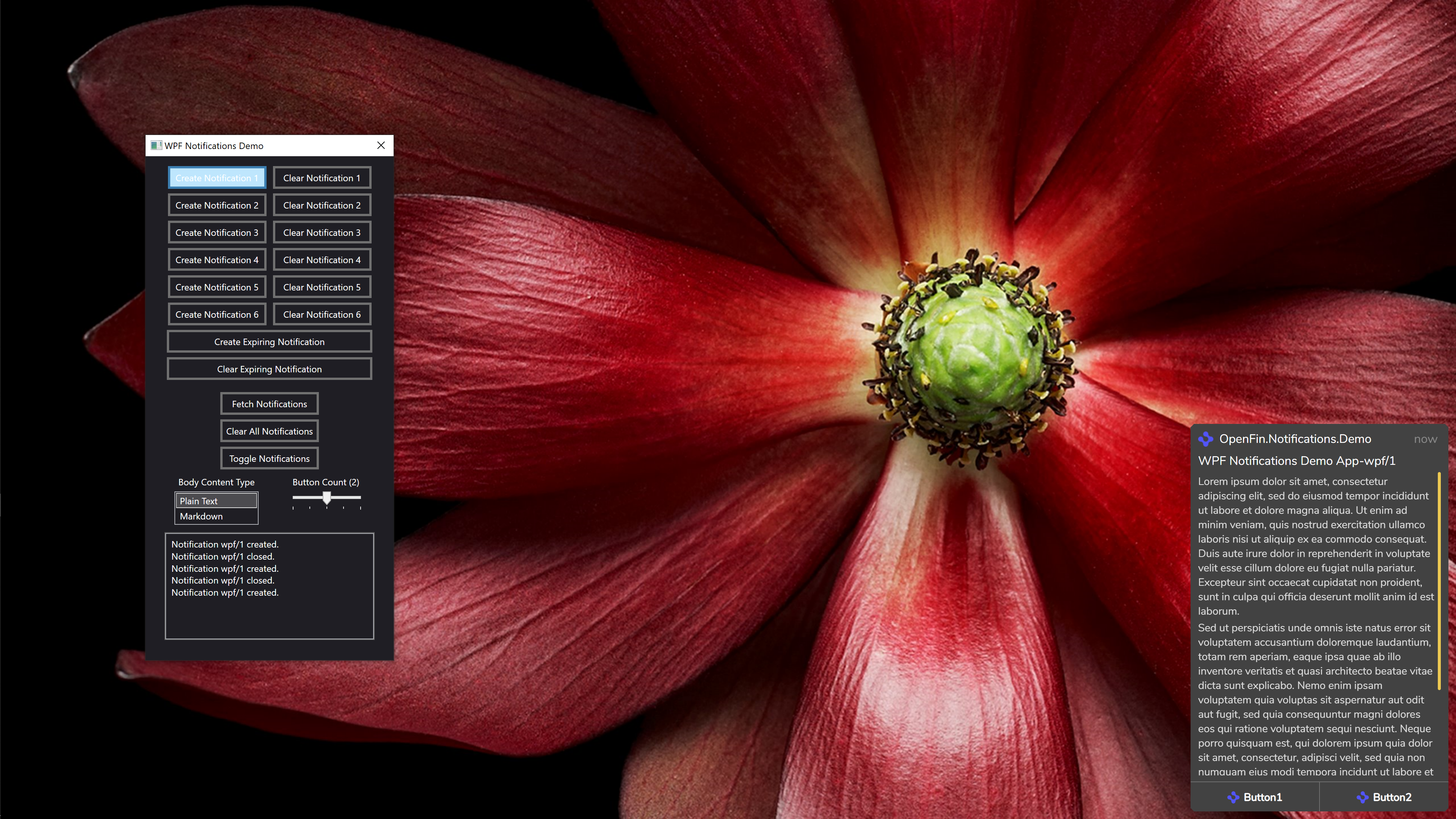The .NET Notifications Service client provides an interface for the Notifications Service allowing notifications to be manipulated from .NET Applications.
OpenFin.Notifications OpenFin Desktop (v10.0 and higher)
The Notification Service API is centered around the static NotificationClient object.
The first call to initialize the client should be to NotificationClient.Initialize() to connect to the provider and register the ChannelClient and topics to respond to events triggered by the provider. The NotificationClient.OnInit action delegate needs to be handled and set before calling Initialize() as follows:
NotificationClient.OnInit => { ...} ;
NotificationClient.Initialize();-
Notifications must have an Id, title, category, and icon
-
Notification bodies can either be plain text or markdown
-
Notifications can have at most 4 buttons
NotificiationClient action delegates facilitate the handling of various notification related events.
The handler for notiifcation actions are invoked when notification buttons and or bodies are clicked or when notifications expire.
The handler for these events are invoked when notifications are closed.
Handlers for these events are invoked when notifications are created.
The OpenFin.Notifications.Demo project is a WPF application demonstrating the notification client's functionality. Functionality demonstrated include creating notifications, deleting notifications, creating expiring notifications, configuring buttons within the notifications, responding to events when notifications are interacted with (body and button clicks) or expire, and toggling the visibility of the Notification Center.
To use the provider hosted in our production environment, the build configuration should be set to Release before the application is built and ran.
To debug the test application, you will need to clone and start the notifications service before starting the .NET client debugger. To build the service you will need Node/NPM. Once node is installed and the repo has been cloned, navigate to the root directory of the service code and issue the following commands:
-
npm install -
npm start
- Fork it (https://github.com/HadoukenIO/dotnet-notification-service-client/fork)
- Create your feature branch (
git checkout -b feature/fooBar) - Read our contribution guidelines and Community Code of Conduct
- Commit your changes (
git commit -am 'Add some fooBar') - Push to the branch (
git push origin feature/fooBar) - Create a new Pull Request
NOTE: Commits and pull requests to FINOS repositories will only be accepted from those contributors with an active, executed Individual Contributor License Agreement (ICLA) with FINOS OR who are covered under an existing and active Corporate Contribution License Agreement (CCLA) executed with FINOS. Commits from individuals not covered under an ICLA or CCLA will be flagged and blocked by the FINOS Clabot tool. Please note that some CCLAs require individuals/employees to be explicitly named on the CCLA.
Need an ICLA? Unsure if you are covered under an existing CCLA? Email help@finos.org
The code in this repository is distributed under the Apache License, Version 2.0
However, if you run this code, it may call on the OpenFin RVM or OpenFin Runtime, which are covered by OpenFin’s Developer, Community, and Enterprise licenses. You can learn more about OpenFin licensing at the links listed below or just email us at support@openfin.co with questions.
Copyright 2018-2019 OpenFin
https://openfin.co/developer-agreement/ https://openfin.co/licensing/

